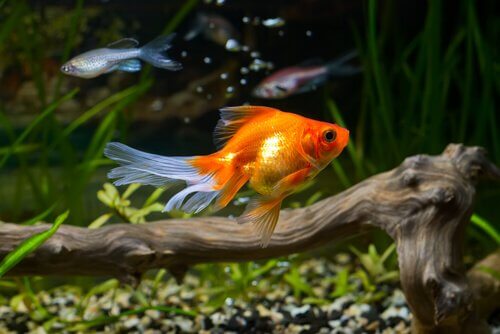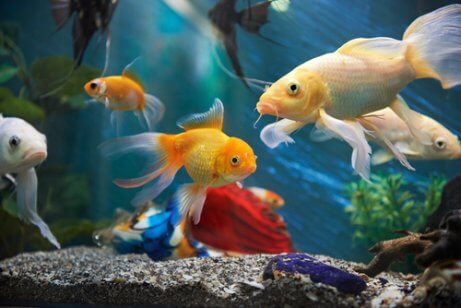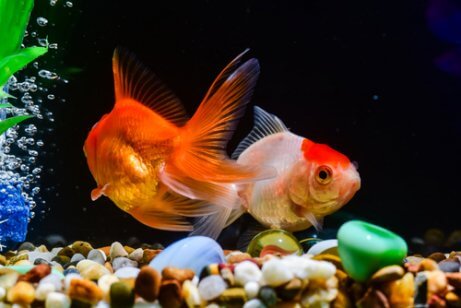Caring For a Goldfish and Potential Diseases

Goldfish, also known as redfish, are one of the most popular species to have in aquariums. Although these fish are fairly resistant to diseases, caring for a goldfish appropriately is important to preserve its good health.
Most common diseases in goldfish
Goldfish are vulnerable to many of the diseases common to aquarium fish. Therefore, when caring for a goldfish, it’s very important to keep the tank clean. This will help prevent many of the diseases that threaten any form of life in the tank.
Here are the main diseases that can affect goldfish:
1. Ich’s disease or “white spot”
White spot is the popular name for one of the most common diseases in goldfish. It is a very contagious disease caused by the parasite, Ichthyophthirius multifiliis, which lodges under the fish’s skin.
However, these parasites need to leave the fish’s body in order to reproduce. As a result of this, they leave small holes in the fish’s skin. What happens then is that cysts form in these holes and more parasites emerge, and they often become infected quickly.
The most common symptom of this disease in goldfish is the appearance of white spots on their skin. However, as the disease progresses, it can also cause respiratory problems, as the gills can become damaged.

2. Dropsy
This is a chronic disease that, initially, doesn’t usually show any symptoms. Dropsy is related to poor maintenance of the aquarium and filters. However, it can also be caused by a poor diet and nutritional deficiencies.
In general, the symptoms only are visible in the most advanced phases of dropsy. In these cases, you’ll observe that the fish swells and its scales bristle and protrude from the body.
When these symptoms are detected, it’s essential to quarantine any infected fish. They should be separated immediately from the healthy specimens. Then, you need to carefully and thoroughly review the hygiene of the aquarium and the quality of the water. We also recommend consulting a specialized veterinarian about the ideal nutrition for each fish.
3. Infestation of leeches
Leeches are ectoparasites of small or medium size that are usually visible to the naked eye. They attach to the skin and nourish themselves on blood. In general, they get into fish tanks when you add new specimens.
The best way to prevent them is to buy fish from approved and reliable stores. In addition, you should check the skin and appearance of new fish well before adding them to the aquarium.
When goldfish have leeches, you can try to remove them carefully. However, to do this, you’ll need a good pair of tweezers and a clean, moist cloth.
First, you need to remove the fish from the aquarium and wrap it gently in the wet cloth. Then, grab the leech delicately with the tweezers. Always grab the leech by the end that is attached to the fish’s skin. With a single, firm pull, remove the leech from the skin. Then, disinfect the wound.
Basic tips for caring for a goldfish
In general, goldfish need the same care as any other aquarium fish to keep them in good health. These are many requirements for caring for goldfish:
- An aquarium appropriate to its size and activity
- Good maintenance, including a good filtering system
- Optimal water conditions
- A complete and balanced nutrition

The ideal aquarium for a goldfish
Goldfish are a cold water fish that adapts better to ponds since they tend to grow a lot. For this reason, when caring for a goldfish in captivity, they need a decent-sized aquarium.
We recommend buying a large tank with at least 40 liters for each fish. For example, a tank with two goldfish would need to hold 80 liters.
After choosing the ideal aquarium for your goldfish, its time to get the best filter for their needs. In most stores, you can ask for advice about the best ones to buy.
Water temperature and pH
Goldfish live naturally in cold or temperate waters, mostly at temperatures of between 60 and 68 degrees Fahrenheit. However, in the wild, many species can withstand temperatures between 40 and 75 degrees.
Depending on the temperature of your home and the time of year, it’s essential to consider the need to heat or cool the water in the aquarium. We also recommend regularly measuring the pH of your fish tank. You should try to keep it close to a pH of 7.
Feeding goldfish
Goldfish are omnivorous animals that enjoy a varied diet. In its natural habitat, this fish usually consumes crustaceans, insects, plants, larvae, and worms.
In specialized stores, you can find special mixtures to feed goldfish. This type of food is ideal because they contain the right proportions of all the necessary nutrients.
With a little attention, caring for a goldfish isn’t very complicated. The color that they bring into your aquarium and the surroundings is well worth it.
All cited sources were thoroughly reviewed by our team to ensure their quality, reliability, currency, and validity. The bibliography of this article was considered reliable and of academic or scientific accuracy.
- Francis-floyd, R., & Reed, P. (2009). Ichthyophthirius Multifiliis ( White Spot ) Infections in Fish. IFAS Extension Univserity of Florida. https://doi.org/10.1103/PhysRevLett.83.1652
